
Meiosis, or reductional division, is a process during which exchange of genetic material between the homolog chromosomes (
crossing-over and recombination) takes place and such a division of the genetical material occurs the four daughercells
have received each only one set of chromosomes (they are haploid, in contrast to the mother cell which contained homolog chromosomes and was diploid)
have each a distinct genetical composition, also different from that of the parental cell.
Meiosis is divided into twofases: meiosis I and meiosis II.
Haploid reproduction cells are the product of meiotic division and a post-meiotic differentiation phase. In animals these cells are directly formed by differentiation (maturation) of the meiotic products. In plants meiotic products progress through mitotic division to meiospores that can further develop to become reproductive cells. (More information and microscopic images © in gamete formation and fertilization).
| Meiosis: timing in the cell cycle and function |
| Meiosis (from the Greek word meion = reduce) comes after the G2-phase, when DNA replication (in the S-phase) is already concluded, so that the cells bear 2n and 4c at the beginning of meiosis. Then DNA is still uncoiled. Two different divisions are distinguished within meiosis, i.e. meisis I (the true reductive division) and meiosis II.
|
(nn).gif) |
+(nn)isnnnn.gif)
| 
|
|
| Meiosis I |
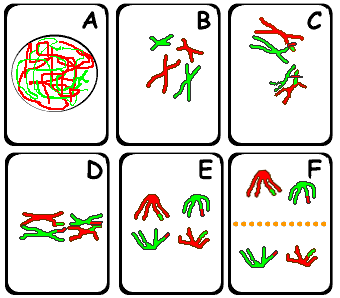 |
|
Meiosis I, the first meiotic division, leads thanks to crossing-over to the formation of daughter cells with a distinct genetical compositions. br>More information and microscopic images (by Dr J.Derksen en Dr. F. Cnudde; with copyrights) can be seen thru the hyperlinks here below. |
|
Pre-meiosis (A): DNA replication is accomplished.
|
Prophase I (B and C).
Prophase I (Gr. pro = before) is divided into:
Leptotene,
Zygotene,
Pachytene,
Diplotene,
Diakinesis
Meiosis I begins with the condensation of the chromosomes (B) in the leptotene during prophase I. During the pachytene (another stage of prophase I) (C) the pairs of homolog chromosomes align to form tetrads in a process called synapsis. Corresponding segments of DNA of sister chromatids of two homolog chromosomes twist and cross, forming so-called chiasmata. In these regions exchange of DNA between homologe chromosomes (C) can occur: crossing-over). Crossing-over (or crossover) requires that the chromosomes break and reconnect to the other chromosome.
|
| Metaphase I (D). In metaphase I (Gr meta= middle) the homolog chromosomes with the already exchanged DNA align as bivalents in the equatorial plane. The chromatides are strongly condensed. Bivalents are positioned in such a way that homolog centromeres lay at either side of the equatorial plane.
|
| Anaphase I (E). Anaphase I (Gr ana = apart) begins when the chromosomes, including piecesf exchanged DNA, are pulled to the opposite poles in the cell. The units of a homolog pair move apart (separation of bivalents) in opposite direction; however, the chromatides of each chromosomes stay joined.
|
| Telophase I (F).
In telophase I (Gr telos = end) the bivalents are separated in two opposite domains in the cell(two poles) and the chromosomes decondense. In some species a new nuclear envelop is formed.
|
| Meiosis II |
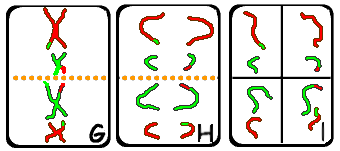 |
|
The second round of division, also called equatoriale division, resembles a normal division. The division plane is perpendicular to that of meiosis I. Meiosis II begins with two haploid cells (or two domains) that contain sisterchromatids with an own composition, and ends with four haploid cells each with an own genetical composition which is carried by single chromatids.
|
Characteristics of the stages of meiosis II
More information and microscopy images copyright; thru hyperlinks |
|
Prophase II (G).
: typical for this stage is the presence of a haploid number of chromosomes that condense again. The two sister chromatides of a chromosome are still coupled together at the centromere.
|
| Metaphase II : The chromosomes move again to the equatorial plane between the poles. However, this plane is oriented perpendicularly with respect to the previous one of meiosis I.
|
| Anaphase II (H).
: The centromeres separate and the sister chromatides are pulled apart to opposite poles by the spindle.
|
| Telophase II (I).
: The former sister chromatides have reached the poles. A nuclear envelop is formed around each nucleus, while chromosome despiralize again.
|
| Meiotic stages: meiosis I and meiosis II |
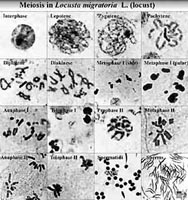
|
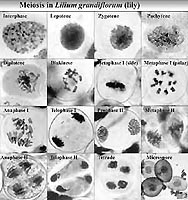
|
|
Grasshopper Locusta migratoria (click on picture to zoom 170 KB; copyright)
| Lily Lilium grandiflorum (zoom 120 KB; copyright) |
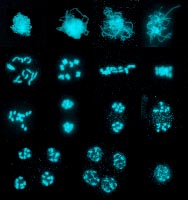
|
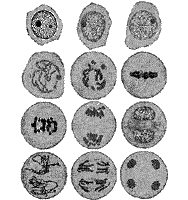
|
|
Petunia Petunia hybrida (zoom 65 KB copyright. More about Filip Cnudde's former research on "Gene expression during male meiosis)
|
Aloe thraskii (according to Schaffstein in Strasburger et al.; 50 KB).
|
| Flash animation of the meiosis |
 Meiosis, or reductional division, is a process during which exchange of genetic material between the homolog chromosomes (crossing-over and recombination) takes place and such a division of the genetical material occurs the four daughercells
Meiosis, or reductional division, is a process during which exchange of genetic material between the homolog chromosomes (crossing-over and recombination) takes place and such a division of the genetical material occurs the four daughercells





